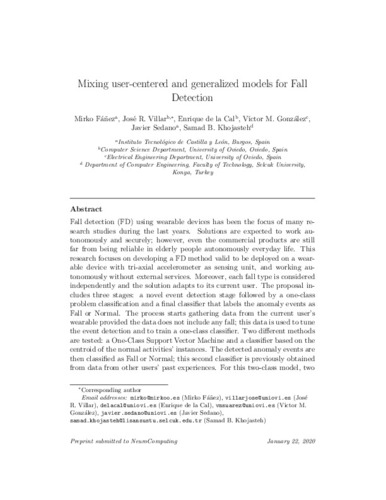Mixing user-centered and generalized models for Fall Detection
Palabra(s) clave:
Fall detection
Machine Learning
One-class classifier
Event detection
Elderly population
Fecha de publicación:
Versión del editor:
Citación:
Descripción física:
Resumen:
Fall detection (FD) using wearable devices has been the focus of many re- search studies during the last years. Solutions are expected to work au- tonomously and securely; however, even the commercial products are still far from being reliable in elderly people autonomously everyday life. This research focuses on developing a FD method valid to be deployed on a wear- able device with tri-axial accelerometer as sensing unit, and working au- tonomously without external services. Moreover, each fall type is considered independently and the solution adapts to its current user. The proposal in- cludes three stages: a novel event detection stage followed by a one-class problem classification and a final classifier that labels the anomaly events as Fall or Normal. The process starts gathering data from the current user’s wearable provided the data does not include any fall; this data is used to tune the event detection and to train a one-class classifier. Two different methods are tested: a One-Class Support Vector Machine and a classifier based on the centroid of the normal activities’ instances. The detected anomaly events are then classified as Fall or Normal; this second classifier is previously obtained from data from other users’ past experiences. For this two-class model, two different options are tested as well: a Support Vector Machine and a feed- forward Neural Network. The experimentation stage includes two different published simulated falls data sets. The obtained results show that filtering the detected peaks corresponding to normal activities of the current user helps the two-class classifier for some types of fall events, suggesting to intro- duce specific one-class filtering per fall type. However, the number of false alarms is still high, and the two-class classifiers have a high variability in their performances according to the user, which still needs further research. The results suggest that it might be interesting to obtain a more accurate two-class classifier using data only from subjects with similar activity levels; the use of online learning might also improve the general performance in the classification stages.
Fall detection (FD) using wearable devices has been the focus of many re- search studies during the last years. Solutions are expected to work au- tonomously and securely; however, even the commercial products are still far from being reliable in elderly people autonomously everyday life. This research focuses on developing a FD method valid to be deployed on a wear- able device with tri-axial accelerometer as sensing unit, and working au- tonomously without external services. Moreover, each fall type is considered independently and the solution adapts to its current user. The proposal in- cludes three stages: a novel event detection stage followed by a one-class problem classification and a final classifier that labels the anomaly events as Fall or Normal. The process starts gathering data from the current user’s wearable provided the data does not include any fall; this data is used to tune the event detection and to train a one-class classifier. Two different methods are tested: a One-Class Support Vector Machine and a classifier based on the centroid of the normal activities’ instances. The detected anomaly events are then classified as Fall or Normal; this second classifier is previously obtained from data from other users’ past experiences. For this two-class model, two different options are tested as well: a Support Vector Machine and a feed- forward Neural Network. The experimentation stage includes two different published simulated falls data sets. The obtained results show that filtering the detected peaks corresponding to normal activities of the current user helps the two-class classifier for some types of fall events, suggesting to intro- duce specific one-class filtering per fall type. However, the number of false alarms is still high, and the two-class classifiers have a high variability in their performances according to the user, which still needs further research. The results suggest that it might be interesting to obtain a more accurate two-class classifier using data only from subjects with similar activity levels; the use of online learning might also improve the general performance in the classification stages.
ISSN:
Patrocinado por:
This research has been funded by the Spanish Ministry of Science and Innovation, under project MINECO-TIN2017-84804-R, and by the Grant FCGRUPIN-IDI/2018/000226 project from the Asturias Regional Goovernment.
Colecciones
- Artículos [37354]
- Informática [865]
- Investigaciones y Documentos OpenAIRE [8230]
Ficheros en el ítem





